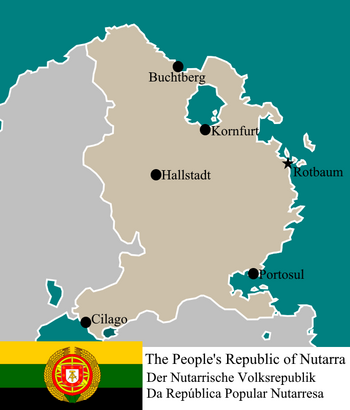Nutarra
Jump to navigation
Jump to search
This article is incomplete because it is pending further input from participants, or it is a work-in-progress by one author. Please comment on this article's talk page to share your input, comments and questions. Note: To contribute to this article, you may need to seek help from the author(s) of this page. |
People's Republic of Nutarra Nutarranische Volksrepublik (Valkian) República Popular Nutarresa (Naocadon) | |
|---|---|
Coat of Arms
| |
| Anthem: Internationale | |
 | |
| Capital | Rotbaum |
| Largest city | Buchtberg |
| Official languages | |
| Demonym(s) | Nutarran |
| Government | Federal presidential council republic |
| Hons Lula | |
| Felix Imhoff | |
| Arthur Lira | |
| Rodrigo Pacheco | |
| Legislature | National People's Assembly |
| Supreme Labor Council | |
| National People's Representative Chamber | |
| Independence | |
• Declared | 7 September 1822 |
| 1 June 1831 | |
• Republic | 15 November 1875 |
| 5 October 1941 | |
| 1 March 1971 | |
| Population | |
• 2022 census | 160,062,512 |
| GDP (PPP) | 2023 estimate |
• Total | |
• Per capita | |
| GDP (nominal) | 2023 estimate |
• Total | |
• Per capita | |
| Gini (2020) | medium |
| HDI (2022) | very high (41th) |
| Currency | Schild (S$) (NTS) |
| Time zone | UTC−2 to −5 (NST) |
| Date format | dd/mm/yyyy (CE) |
| Driving side | right |
| Calling code | +55 |
| Internet TLD | .nt |
Nutarra, officially the People's Republic of Nutarra is a country in Eastern Cesylle. The country is bordered by (placeholder) to the west and (placeholder) to the south. It has a population of 160 million, making it the most populated on Cesylle. Its capital is Rotbaum, and its most populous city is Buchtberg. Nutarra is a Federal Council Republic composed of 21 states. It is the only country on Cesylle to have Naocadon as an official language. Nutarra is in the Alliance for Socialist Liberation and its economy is a computerized socialist planned system.
